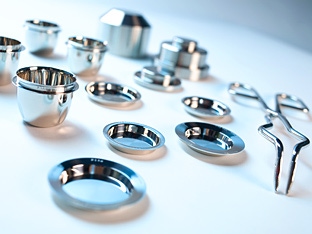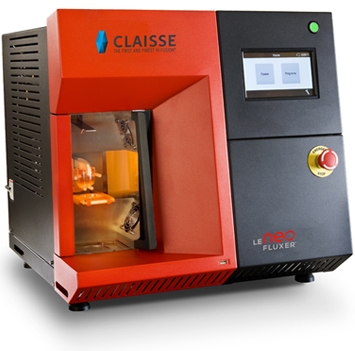The chemistry department of Université de Paris is well known for its research and educational programs. It includes 500 undergraduates, 70 doctoral and postdoctoral candidates, and more than 90 academics working in a shared lab facility (chemistry, physics and earth sciences) using state-of-the-art instruments and technologies1. A wide range of samples such as metals, ceramics, polymers, and nanomaterials are analyzed in the ultramodern X-ray analysis lab at the university.
Dr. Sophie Nowak is responsible for the X-ray platform and XRF analysis systems at the department. Since she works in an academic institution involving numerous scientists with their own fields of interest, she needs robust analytical methods that can be adapted to various types of samples.
She encountered an issue a couple of years ago related to the analysis of volcanic ashes, which are known to be very variable and for which the composition must be known quickly.
 The chemistry department of Université de Paris is well known for its research and educational programs. It includes 500 undergraduates, 70 doctoral and postdoctoral candidates, and more than 90 academics working in a shared lab facility (chemistry, physics and earth sciences) using state-of-the-art instruments and technologies1. A wide range of samples such as metals, ceramics, polymers, and nanomaterials are analyzed in the ultramodern X-ray analysis lab at the university.
The chemistry department of Université de Paris is well known for its research and educational programs. It includes 500 undergraduates, 70 doctoral and postdoctoral candidates, and more than 90 academics working in a shared lab facility (chemistry, physics and earth sciences) using state-of-the-art instruments and technologies1. A wide range of samples such as metals, ceramics, polymers, and nanomaterials are analyzed in the ultramodern X-ray analysis lab at the university.
Dr. Sophie Nowak is responsible for the X-ray platform and XRF analysis systems at the department. Since she works in an academic institution involving numerous scientists with their own fields of interest, she needs robust analytical methods that can be adapted to various types of samples.
She encountered an issue a couple of years ago related to the analysis of volcanic ashes, which are known to be very variable and for which the composition must be known quickly.
 The chemists working at the X-ray platform used press pellets to prepare their volcanic ashes for XRF analysis. However, they found out the granulometry and matrix induced by the press pellet technique affected the results. The preparation step was time-consuming, and it involved the use of a large quantity of the sample (about 1 g), which was an issue because this quantity is not always available depending on the samplings.
The chemists working at the X-ray platform used press pellets to prepare their volcanic ashes for XRF analysis. However, they found out the granulometry and matrix induced by the press pellet technique affected the results. The preparation step was time-consuming, and it involved the use of a large quantity of the sample (about 1 g), which was an issue because this quantity is not always available depending on the samplings.
They consulted Malvern Panalytical experts and switched to the fusion technique in 2016 using LeNeo® instrument. Fusion was better for them since the granulometry/matrix effect was removed. They gained accuracy, precision and reproducibility in the XRF results. They were also able to retrieve some relevant information such as loss of ignition for their samples.
However, they quickly found out that the 30 mm platinum mold that was initially used to produce the glass disks was not fully adapted to their needs. Since the X-ray beam size of their XRF – a Malvern Panalytical Epsilon 3XL – was small, they needed a smaller mold to maximize the use of the volcanic ashes samples. Once again, they reached out to Malvern Panalytical for customized platinum accessories and were provided with a 13 mm mold (requiring only 116 mg of sample).
According to Mrs. Nowak, they are now able to make over 500 analysis per year (compared to 0 in 2015) thanks to the technical support of Ivonne Cocca, who has been working at the platform since 2016 and who is now specialized in sample preparation by fusion.
The ROI stands in the fact that Malvern Panalytical provided the scientists working at the X-ray platform with a solution that made the analysis of volcanic ashes samples possible and reliable. Over time, they managed to become one of the reference laboratory in France for the analysis of this tricky type of samples. In fact, they are now part of a volcano observatory center and receive samples whenever a volcano erupts in Réunion or Mayotte islands. Within one hour, they can determine the magnesium content and other chemical composition to evaluate the magnitude of the eruption.
The smaller platinum mold also provides them with the desired results since it avoids unnecessary loss. They can keep more of the samples for other techniques/areas of research interests and pursue their educational mission.
“I like to work with Malvern Panalytical experts since they provide me with customized solutions that really make a difference in my lab. The staff is proactive and always willing to innovate to provide creative and clever solutions to obtain the desired outcomes.” Sophie Nowak – Responsible for the X-ray platform at Université de Paris.
“Without fusion, it would have been simply impossible for us to properly analyze volcanic ashes.” Sophie Nowak – Responsible for the X-ray platform at Université de Paris.